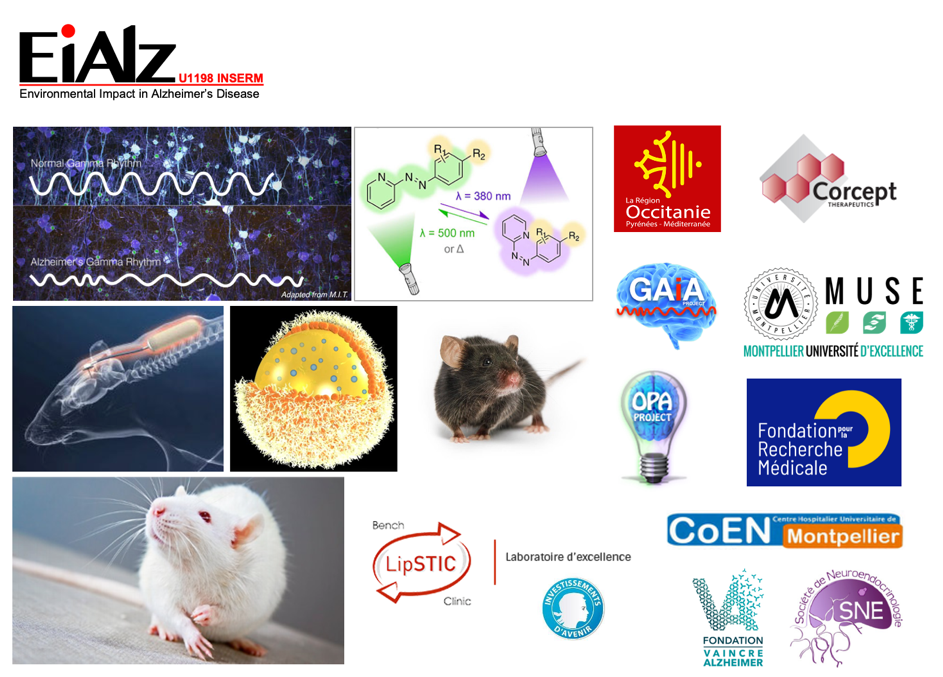group 4: Environmental Impact in Alzheimer’s Disease
About
Some factors have been identified to increase the risk to develop Alzheimer’s disease (AD). Indeed, a number of genetic mutations inevitably lead, without any possibility of intervention, to the early development of familial forms of AD (less than 2% of patients). In the case of sporadic, age-related forms, numerous studies suggest the existence of exogenous and therefore modifiable risk factors: these late-onset forms of AD seem to result from a complex combination of genetic determinants and environmental or lifestyle factors, which will contribute to the development of the disease over several decades.
The main objective of our work is to characterize in vivo and in vitro the impact of environmental factors on the etiology of AD. In particular, we are focusing on the impact of oxidative stress and carbonyl stress (COS). These two types of stress, which are closely linked, increase through exposure to a number of highly reactive compounds present in fried foods, cigarette smoke and motor vehicle exhaust....
We have developed various in vitro and in vivo models to assess and characterize the impact of COS in the etiology of AD.In parallel, we are testing innovative preventive and/or therapeutic strategies based on the use of lipophenols, hybrid compounds targeting COS (collaboration with Dr. C. Crauste, IBMM Montpellier), which we administer intranasally.
These projects are currently supported by the Labex LipSTIC and the France Alzheimer fondation .

Group
Catherine Desrumaux, group leader
 |
Research Fellow, Inserm Contact: catherine.desrumaux-piazza(at)umontpellier.fr Phone: 04 67 14 36 89 |
Léa Oteagui
 |
PhD Student Contact: lea.otaegui(at)etu.umontpellier.fr Phone: 04 67 14 36 89 |
References
- Canet G, Pineau F, Zussy C, Hernandez C, Hunt H, Chevallier N, Perrier V, Torrent J, Belanoff JK, Meijer OC, Desrumaux C, Givalois L (2020) Glucocorticoid receptors signaling impairment potentiates amyloid-β oligomers-induced pathology in an acute model of Alzheimer’s disease. FASEB J 34, 1150-1168.
- Lafon PA, Wang Y, Arango-Lievano M, Torrent J, Salvador-Prince L, Mansuy M, Mestre-Francès N, Givalois L, Liu J, Mercader JV, Jeanneteau F, Desrumaux C, Perrier V (2020). Fungicide residues exposure and β-amyloid aggregation in a mouse model of Alzheimer’s disease. Environ Health Persp 128, 17011.
- Canet G, Hernandez C, Zussy C, Chevallier N, Desrumaux C, Givalois L (2019) Is AD a stress-related disorder? Focus on the HPA axis and its promising therapeutic targets. Front Aging Neurosci 11, 269.
- Zub E, Canet G, Garbelli R, Blaquiere M, Rossini L, Pastori C, Sheikh M, Reutelingsperger C, Klement W, de Bock F, Audinat E, Givalois L, Solito E, Marchi N (2019) The GR-ANXA1 pathway is a pathological player and a candidate target in epilepsy. FASEB J 33, 13998-14009.
- Desrumaux CM, Mansuy M, Lemaire S, Przybilski J, Le Guern N, Givalois L, Lagrost L (2018) Brain vitamin E deficiency during development is associated with increased glutamate levels and anxiety in adult mice. Front Behav Neurosci 12, 310.
- Mansuy M, Baille S, Canet G, Borie A, Cohen-Solal C, Vignes M, Perrier V, Chevallier N, Le Guern N, Deckert V, Lagrost L, Givalois L, Desrumaux C (2018) Deletion of plasma Phospholipid Transfer Protein (PLTP) increases microglial phagocytosis and reduces cerebral amyloid-β deposition in the J20 mouse model of Alzheimer's Disease. Oncotarget 9, 19688-703.
- Canet G, Chevallier N, Zussy C, Desrumaux C, Givalois L (2018) Central role of glucocorticoid receptors in Alzheimer's disease and depression. Front Neurosci 12, 739.
- Zussy C, Gómez-Santacana X, Rovira X, De Bundel D, Ferrazzo S, Bosch D, Asede D, Malhaire F, Acher F, Giraldo J, Valjent E, Ehrlich I, Ferraguti F, Pin J-P, Llebaria A, Goudet C (2018) Dynamic modulation of inflammatory pain-related affective and sensory symptoms by optical control of amygdala metabotropic glutamate receptor 4. Mol Psychiatry 23, 509-20.